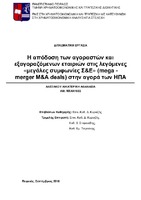H απόδοση των αγοραστών και εξαγοραζόμενων εταιριών στις λεγόμενες «μεγάλες συμφωνίες Σ&Ε» (mega - merger M&A deals) στην αγορά των ΗΠΑ

View/
Keywords
Συγχωνεύσεις – εξαγορές ; Μέθοδος ανάλυσης γεγονότων ; Μη κανονικές αποδόσεις μετοχών ; Μεγάλες συμφωνίες ; Mergers and acquisitions ; Event study ; Abnormal returns ; Mega dealsAbstract
The present thesis examines the cumulative average abnormal returns (CAARs) of the acquirers within the US market, focusing on the so-called mega M&A deals for the period 1990-2017. The main goal of our study is to investigate if these CAARs are different in the period before and after the financial crisis of 2008 and to detect the causes of this difference, if there is any at all.
More specifically we apply the standard event study methodology to estimate the Abnormal Returns of the short-term announcement window, using the Market Model for a final sample of 1,146 completed domestic deals of US acquirers. In order to discover the determinants of the Abnormal Returns, we employ a series of variables, which besides the size of the deal (mega deals>500 mln.$), are the mode of payment, the ownership status of the target firm (private vs. listed) and the most important of all, the period of time (in relation with the year 2008), as well as the relatedness of the acquisition event (related vs. unrelated takeovers).
Our findings from the first part of our analysis (univariate analysis) more or less confirm that after the crisis the cumulative average abnormal returns of the acquirers are statistically significantly higher in the case of mega deals, and cash offers. These results are in basic terms in agreement with those reported by the study of Alexandridis et al. (2017) who justified them on the basis of the argument that both investors and the management of the acquiring companies in the post-2008 period made a better and more careful planning of the M&A deals- especially the mega deals- they executed increasing the shareholders’ value.
However, the significance of these factors was not vindicated in the second part of our analysis, namely the multivariate regression analysis.


